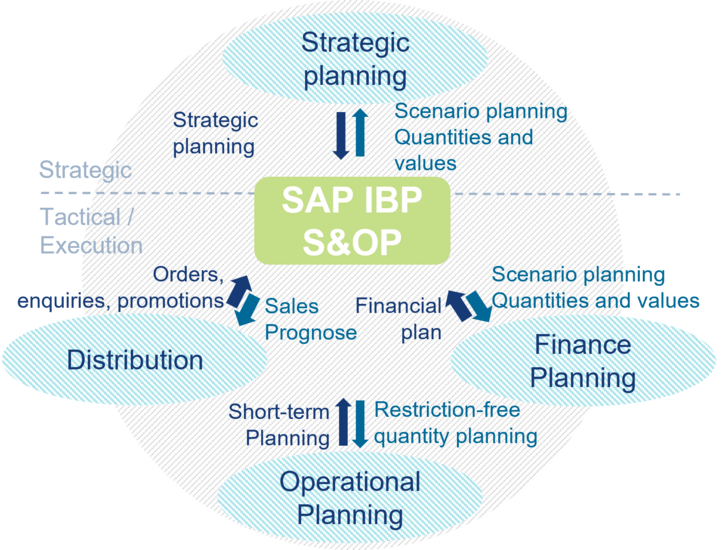As many companies have already experienced for themselves in recent years, disruptions in the global supply chain due to changes in trends or market turbulence of a geopolitical, ecological, social or competitive nature will be the order of the day in the future. This is also confirmed by my observations as a supply chain architect of many years' standing. Users need suitable solutions to effectively meet these challenges. The future-proof maintenance of economically profitable production can only be achieved with end-to-end transparency across the entire supply chain.
Although the digital tools do not eliminate the hurdles, they do help to realistically assess the risks along the entire value chain, making them transparent and controllable. This optimal balance between responsiveness and delivery capability, inventories, lead times, sustainability (circular economy) and customer satisfaction enables a proactive response to the volatile market. SAP Integrated Business Planning (IBP) is a powerful solution that helps to overcome these challenges.
What sets IBP apart from the competition
Thanks to its architecture, the cloud-based IBP solution offers real-time planning in an integrated environment and ensures a seamless transition between demand and the corresponding plans for logistics, production and procurement. IBP uses innovative forecasting methods and planning algorithms for production, distribution and procurement. This ensures transparency of requirements, inventories and capacities along the entire supply chain.
By using targeted inventory optimization, IBP guarantees delivery readiness across the entire supply network. The consequences of changes and alternative decisions can be proactively estimated in simulations of various planning scenarios. The fully integrated solution thus allows a controllable balance between production capacity utilization, inventory optimization, delivery service level and profitability of the company, taking into account possible disruptions.
Planning includes suppliers and values
With IBP, supply chain planning is possible far beyond the narrow limits of the ERP systems used to date in order to include suppliers' suppliers (Tier 2) in the forecasts or to avoid overloading the production capacities of an extended workbench. Company locations that are not yet connected to an ERP system, such as regional sales offices, can also be easily connected via the cloud.
One highlight of IBP is value planning, which not only enables material quantities but also a planning view of the values, taking into account currencies, costs and revenues. For example, planning takes into account forecast exchange rates or sales prices and thus enables important simulations for what-if scenarios such as price increases or the forecast of contribution margins. In terms of company-wide sales and operations planning, IBP also includes areas such as finance and controlling, which ensures holistic, fact-based planning. The company's entire budget planning is also possible with IBP.
Integrated Business Planning: what's under the hood
Inadequate planning processes impair communication along the supply chain and, in the worst case, cause a lot of costs. SAP Integrated Business Planning closes such gaps in the information and planning process with the following modules, giving companies a complete overview of demand, stocks and capacities along their supply chains at all times.
- The Supply Chain Control Tower provides an up-to-date overview of the entire supply chain and delivers meaningful analyses with aggregated or disaggregated planning data and business scorecards. Combined with tools for exception management, it focuses on the important decisions.
- Sales & Operations Planning enables the desired sales and financial targets to be compared with production capacity in an integrated planning process. It also offers extensive functions for scenario modeling and support for internal company collaboration.
- Demand Planning supports companies with a forecasting process in which short-term demand signals such as daily fluctuations ("demand sensing") are taken into account in addition to long-term demand forecasts. This module includes statistical forecasting methods, analyses, consensus planning and (long-term) statistical modeling.
- Supply Planning creates a multi-level production plan that compares requirements and production capacities and offers the option of comparing "what if" scenarios in production planning.
- Inventory Planning uses a dynamic statistical approach, coupled with scenario analysis, to build an optimal supply chain network and inventory planning.
- Response Planning generates a short- to medium-term delivery plan that uses prioritized and categorized requirements to combine product allocations, schedules and availability commitments (ATP) in the best possible way.
Important to know: Not all modules are essential for every company. Each module can be licensed separately and used individually or in combination. It is advisable to check with an experienced partner such as CONSILIO which modules actually add value.
Intuitive and a team player
The IBP user interface is browser-based ("Fiori") or Microsoft Excel, making it user-friendly and quick to learn. Supported by predefined and customizable dashboards, KPI analytics and interactive analyses, IBP increases global transparency across all planning processes. The self-explanatory presentation with supporting diagrams and graphics increases user acceptance and keeps the training effort to a very low level.
Focus on cooperation
Different employees or specialist departments are often involved in a planning process. To make joint planning more effective, IBP offers the option of coordinating the demand, supply and planning process with IBP Workflows and SAP JAM.
Summary
Integrated business planning with IBP combines the areas of sales, marketing, finance, procurement and production in order to optimize costs, service and inventories. It focuses on all areas of planning, from long-term and strategic planning to medium-term planning and execution. Synchronized end-to-end planning to align supply with customer demand helps separate demand signals from market noise and enable step changes in service, inventory and overall equipment effectiveness (OEE). Digital planning transformation, advanced monetization, integrated business planning and scenario modeling by leveraging leading technologies, simulation and artificial intelligence (AI) help improve forecasting and planning outcomes and reduce planner effort. In addition, IBP can be perfectly combined with SAP MP&S (formerly PP/DS) detailed planning.





